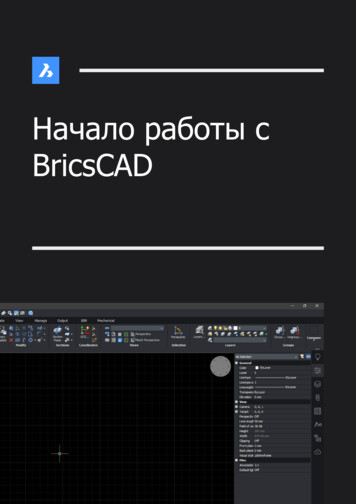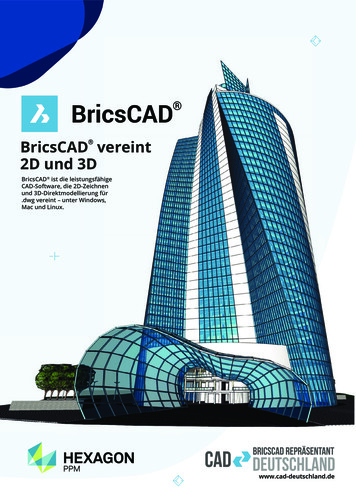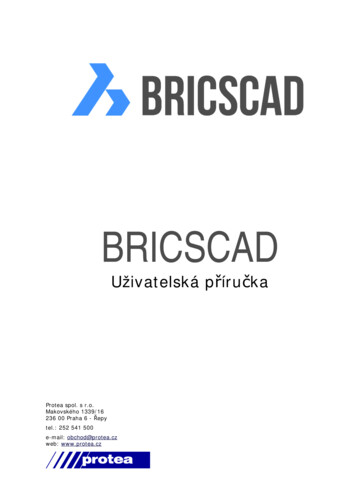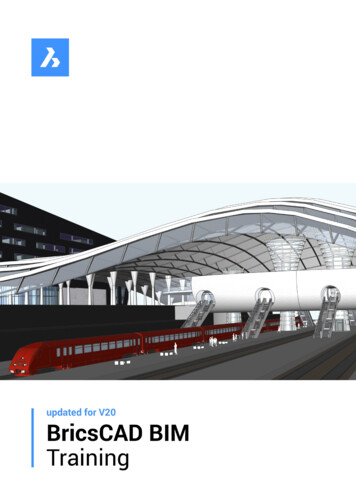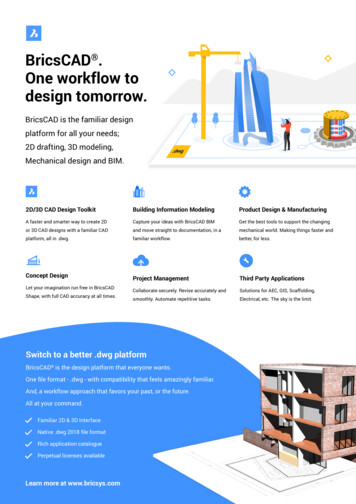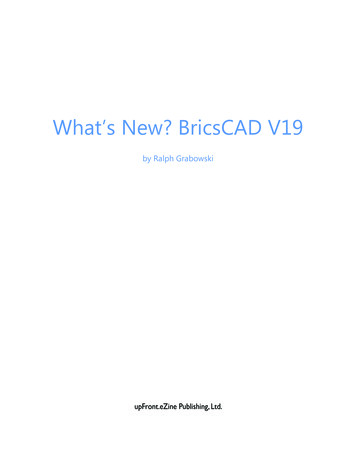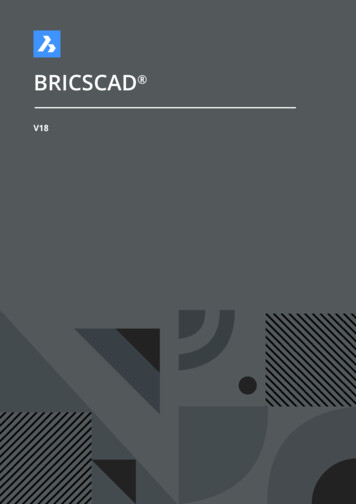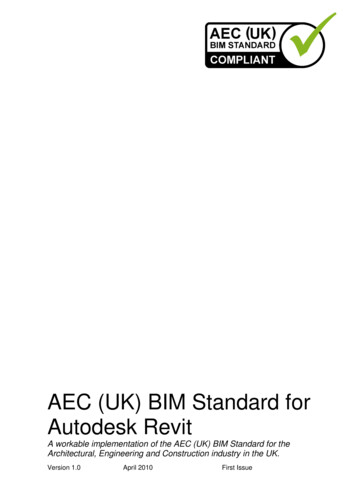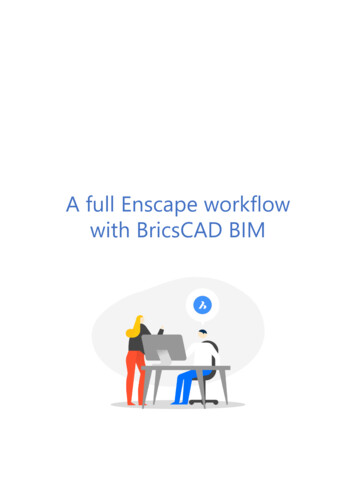
Transcription
A full Enscape workflowwith BricsCAD BIM
Contents0. Introduction . 11. System requirements How to Install the Enscape-plug in . 12. Navigate your model in Enscape . 23. How to apply Render materials with the Render materials Panel . 44. Using Enscape keywords . 75. How to apply Render materials with Compositions . 96. How to create Saved Views . 117. How to add Components to the model . 118. How to create Render images . 159. How to create Render videos . 1610. Create a Stand alone .exe . 170. Introduction The step-by-step instructions also have figures included to provide additional context for select steps. Modules have “starter .dwg files” that should be used. The text in “bold blue” indicates BricsCAD BIM commands. The text in “bold black” is inserted and/or selected values/items. This exercise is in metric units (mm).Enscape is a real-time rendering plugin for BricsCAD. With a single click, you can start Enscape in seconds and walk through your fully rendered 3Dmodel. There is no need to export to other programs. All changes in BricsCAD are immediately available for display and evaluation in Enscape.You can quickly explore different materials and design options to present to clients. With the option to create output renders, videos, andpanoramas of your project, you can send the output files to your clients or colleagues, which allows for quick demonstrations. You can edit thechanges in BricsCAD, and Enscape will immediately show the changes you have made to the project.Note: Before you start this Enscape training, it’s preferred that you already have some basic knowledge about BricsCAD BIM. In this training, therewill be some references to components, compositions, level of detail, BIM sections, etc. Thus, it is recommended that you first follow the V20 BIMTraining, you can watch video tutorials on the Bricsys YouTube channel and download the documents needed for the training merF82oH0YJgPZyM1
1. System requirements How to Install the Enscape-plugin1.1System requirementsThe minimum requirements to run Enscape: Windows 7 64 Bit or higherIntel i5 CPU or higherNVIDIA or AMD GPU with 2GB VRAMSupports OpenGL 4.3NVIDIA GeForce GTX 660/Quadro K2000 and newerAMD Radeon R9 260/FirePro W5100 and newer4 GB RAM (8 GB recommended)2 GB Video-RAM (4 GB recommended)For more information about Enscape system requirements, visit /systemrequirements/.For more information about Enscape specific features, you can visit their knowledge-base on their website.1.2How to install the Enscape plug-in1.Download the Enscape-BricsCAD Connection from the Application Store, see start page BricsCAD V20 that redirects to the correctwebpage: r-bricscad-real-time-rendering-a1358-al23672.The installer copies the necessary files to the ‘Program Files\Bricsys\Enscape’-folder.3.Restart BricsCAD V20.4.You now have a new tab named ‘Enscape’ in the ribbon of BricsCAD.Note: The first time you will start the Enscape-plugin, you will be asked to provide a license key. If you don’t have a license keyyet, you can start by choosing the trial option.1.3How to uninstall the Enscape plug-inUninstall the connector from ‘Add or Remove Programs’ in Windows, by searching on ‘Enscape’ and click ‘Uninstall’.1.4Before we start1.Copy the content (folders: ‘Enscape training’ and ‘.resources’) inside the folder ‘Materials used in training’.2.And Paste them in the following path: ls.3.Make sure the Render materials directory path in the BricsCAD settings has the following terials) to make sure the ‘Enscape training’-folder will appear in the Rendermaterials Panel.2. Navigate your model in Enscape2.1In the BRICSCAD window1.Open ‘Villa model start Enscape.dwg’.2.Open the Enscape tab in the ribbon.2
3.2.22.3Click START ENSCAPEto open the Enscape window.In the ENSCAPE window1.Starting in FLYMODE, fly closer to the house by pressing the W CTRL-key.2.When you are above the floor slab, you can switch to WALKMODE by pressing the Space bar.3.You can click the mouse to adjust the views.4.Other Navigate Instructions in Enscape:Enscape SettingsIn the BRICSCAD windowOpen the Enscape Settings dialog by clicking SETTINGSinthe ribbon or type in ENSCAPESETTINGS in the commandline.You can find more information about saving and importing presetsin the following link:The Enscape Settings consists of 7 tabs: General: general Rendering style options, Depth of fieldand Exposure settings. You can find a more in-depthexplanation in the following tutorial link:https://youtu.be/0PqtiBoDxEY Image: Contrast and Color settings. You can find a morein-depth explanation in the following tutorial link:https://youtu.be/mbZ7wKBF0zE Atmosphere: Horizon/background options, Fog, Cloudsand Sky orbs. You can find a more in-depth explanationin the following tutorial link:https://youtu.be/PkcHJeV3lMM Input: Mouse navigation settings Advanced: Spectator options. You can find a more indepth explanation in the following tutorial link:https://youtu.be/bZtQfkCVdP4 Capture: Image, Video and Panorama options. You canfind a more in-depth explanation in the following tutoriallink: https://youtu.be/MrY8DuNx3v0 Customization: Interface options.3
2.4Load Enscape PresetsIn the BRICSCAD window1.Open the Enscape Settings dialog by clicking SETTINGSin the ribbon or type in ENSCAPESETTINGS in thecommandline.2.Click Presets on the upper left corner of the dialog.3.Choose Load Preset.4.Choose the file ‘trainingsettings.json’ in the Starter filesfolder.5.Click OK to exit the Settings dialog.Note: You can restore to the default settings by clickingPresets and choose Reset to Default.3. How to apply Render materials with the Render materials PanelIn BricsCAD, there are two methods to add render materials to your model. Directly apply render materials (without compositions) to the solids/surfaces in your model, using the Render materials Panel. Apply render materials via compositions, using the Compositions Panel (see chapter 5).In this training, both methods will be explained. Let’s start with the first method: Applying render materials with Render Materials Panel.For more information about Render materials in BricsCAD, you can visit our Help page: 0754-Rendering-MaterialsNote: When Render materials are attached to an entity both applied directly with the Render materials Panel and compositionsattached, the composition materials will be shown (when Level of detail 2).Thus, if an entity already has a composition and you want to change the render material, don't try to 'overrule' it with the Rendermaterials Panel, but change the composition plies instead.3.1In the BRICSCAD window1.Zoom into the terrace of the house.2.Note: You should still see the full house on your BricsCADwindow, otherwise Enscape will not fully render the house andyou will have missing parts in the Enscape window.3.Click on the slab in front of the house.4.Open the Render materials Panelon the right-handside of your screen. If the panel is not shown, right-click a4
blank menu area and select Render materials.5.It should appear with an icon in the Tool Panel. If it appears asa standalone, drag it over Tool Panel and position cursor untilthe large rectangle turns blue and release.6.Select the folder Woods in the Render materials Panel.7.Select a wooden material wanted, for example, ‘Light Wood’and drag it into the model and drop it on the slab youselected previously.Note: you can also double-click the material wanted, and thematerial will apply to all the selected entities3.2Creating new MaterialsIn the BRICSCAD window1.Open the Materials dialog by typing MATERIALS in the commandline or by opening the Drawing Explorer. Here are all thematerials, used in your drawing, listed. The materials of the composition plies are also listed here.2.Click on the icon New to add a new material.3.Give the new material a name, for example ‘Wooden Planks’.4.Check on Diffuse map and add a texture image by adding a path.5.Choose ‘Planks11 col.jpg’ as the texture image in the folder ‘[4K]Planks11’.Note: You can download some of your own texture images, I downloaded mine from CCOTextures.6.Check on Bump map and add a normal image by adding a path.7.Choose ‘Planks11 nrm.jpg’ to add as a bump map:8.Change the scale of the maps from 1 to 2000 for both Width and Height.9.Close the Materials dialog.5
3.3In the BRICSCAD window1.Select the same slab again.2.Open the Properties Panel. There you will find adropdown menu under 3D Visualization Material of allthe materials used in this drawing.3.Go to Materials and change the material from ‘Light Wood’ tothe newly created material ‘Wooden Planks’.4.You can see that the newly created material looks morerealistic since the texture image is a higher quality image andyou added a bump map.In the ENSCAPE window5.3.4You can pan around the Enscape view to see the results.Add material(s) to libraryIn the BRICSCAD window1.Open the Materials dialog again.2.Go to the material ‘Wooden Planks’ and hover the cursor overit.3.Right-click and select Add material(s) to library.4.Close the Materials dialog.5.Open the Render materials Panel.Now a new folder is added named ‘User defined’. In thisfolder, you can find the ‘Wooden Planks’ material you havejust created. Now you can use this material on in otherdrawings as well.3.4Edit existing render materialsIn the BRICSCAD windowBefore we start saving views, let’s first adjust some render materialssettings of the Window components to make it more realistic inEnscape.1.Show the windows layers in the Layer Panelwhere it isassigned to. WINDOW FRAME and WINDOW PANEL shouldbe assigned with METAL and GLASS-layer with materialGLASS.2.Close the Layer Panel.3.Open the Materials dialog.4.Change the following settings for METAL:- Diffuse: shade of grey- Highlights: Metallic- Glossiness: 506
5.Change the following settings for GLASS:- Diffuse: shade of blue- Glossiness: 95- Transparency: 95- Refraction Index: 1.22- Reflectivity: 606.Make sure to REGENyour materials in your drawing tobe sure that the changes are applied.4. Using Enscape keywords4.1In the BRICSCAD window1.Go back to the Home page of the Render materials Panel.2.Select folder ‘Enscape training’3.Choose material named ‘Ground’ and drag and drop it onthe remaining (white) slab without any material.In the ENSCAPE window4.4.2You can pan around the Enscape view to see the results.Keyword: GrassIn the BRICSCAD window1.Go to the Materials dialog.2.Search for the material you have just added ‘Ground03’.3.Double-click on the material to change the name.4.Change the name from ‘Ground03’ to ‘Grass’.Any time the word ‘Grass’ is used in a material name, grass will berendered in Enscape. You can use diffuse colors to chooseoptions of green, but also texture maps can be used as well.4.3Keyword: WaterIn the BRICSCAD window1.Open the BIM section ‘Floor 0’ by double-clicking thesection plane or Quad select CLIPDISPLAY.7
In the ENSCAPE window2.You can pan around and check the grass rendered inEnscape.3.Walk/Fly over to the swimming pool of the house.Note: since you have activated the BIM section, you can see livechanges of your BIM model in Enscape. Everything you change inBricsCAD like deleting, adding, replacing entities, will be updatedin real-time in Enscape. You can turn this off by clicking TOGGLEOFF LIVE UPDATESin the BricsCAD ribbon or type inENSCAPETOGGLELIVEUPDATE in the commandline.In the BRICSCAD window4.Zoom into the swimming pool.5.Select the solid in the pool.6.Open the Render materials Panelfolder named ‘Water’.7.Drag and drop material ‘Water Blue Two’ into the drawing.and choose theAny time the word ‘Water’ is used in a material name, water willbe rendered in Enscape. You can also create your own watermaterial by including the word ‘water’ in the material name andgive it a diffuse color in a shade of blue.4.4In the BRICSCAD window1.Go back to the Home page of the Render materials Panel.2.Select folder ‘Enscape training’3.Choose material named ‘Tiles22’ and drag and drop it onthe remaining (white) slab by the swimming pool.Note: you can also double-click the material wanted, andthe material will apply to all the selected entities4.Close the BIM section.5.Close the Render material Panel.In the ENSCAPE window6.You can pan around the Enscape view to see the results.8
5. How to apply Render materials with Compositions5.1Add a new compositionIn the ENSCAPE window1.Fly and zoom into the corner of the walls.In the BRICSCAD windowSince this is a BIM model, all the solids are classified as a BIMbuilding element, like walls and slabs. Compositions are attachedto these building elements. When we turn on the Level of Detail(LOD) in this drawing, you will see the render materials attachedto the compositions of each building element.2.Turn ON the LEVEL OF DETAILto display the rendermaterials of the composition plies or type inLEVELOFDETAIL in the commandline and set it to 2.Note: Render materials used in compositions will overrideexisting materials (added with the Render materials Panel,see chapter 3) attached to the solid.3.Select the wall on the corner of the house.4.Open the Compositions Panel. Click on thehamburger menu on the right to Show only compositionsin project.5.Use the Structure Browserwith configurationclassification.cst to select all 3D Solid entities in thedrawing.If you don’t have the classifications.cst, it is provided in the‘Starter files’-folder, copy and paste the .cst in thesupportfolder. You can open the supportfolder by typingSUPPORTFOLDER in the commandline.6.Choose ‘Concrete Blocks’ from the Compositions Panel.7.Drag and drop the chosen composition onto the 9 solidsselected.8.Double-click the ‘Concrete Blocks’ composition, theCompositions dialog will appear.Here you can define the appearance and materials for eachply in the composition.9.Double-click the ‘Concrete, Precast’ material and thePhysical Materials dialog will open.10. In the tab Appearance, you can see the render materialused for this composition. In this case, it is ‘Concrete38’.9
5.2Edit an existing compositionIn the ENSCAPE window1.Pan around to check the newly added concrete material.2.Switch back to WALKMODE by pressing the Space bar andwalk to the exterior wall on the side of the house.In the BRICSCAD window3.Select the wall.4.Open the Properties Panelto check the compositionof the wall: Exterior wall, Brick, Plaster, 360 mm.5.Open the Compositions Panelcomposition that was used.6.Double-click the composition ‘Exterior wall, Brick, Plaster,360 mm’, the Compositions dialog will appear.7.Double-click the material ‘Supporting Wall, ConcreteBlocks’, and the Physical Materials dialog will open.8.In the tab Appearance, you can see the Render materialused for this composition. In this case, it is ‘Concrete03’.9.Click on the Render material image and a dialog will pop upwith a list of render materials in your library.and find the same10. Type in the search bar ‘Enscape training’ to find the brickmaterial wanted.11. Select the render material ‘BrickWall’.12. Click OK to close the dialog.5.3Reapply the adjusted compositionIn the BRICSCAD window1.Open the Structure Browserclassification.cst.with configuration2.Select all the exterior walls with composition ‘Exterior wall,Brick, Plaster, 360 mm’.3.Drag and drop the composition again into the drawing, onthe 12 exterior walls.4.Check the reference faces: all the reference face should beon the exterior surface of the wall. The two walls in front ofthe terrace slab, have the reference face on the interior side,so we will have to flip the reference face of both walls.5.Press Enter to finish applying,6.Close the Structure Browser and the Compositions Panel.10
6. How to create Saved Views6.1In the BRICSCAD window1.Navigate using zoom and orbit, to the dining area until youget a similar view (see image on the right).Note: Make sure your viewing style is in Perspective to havea more accurate saved view in Enscape. You can check this inthe Properties Panel View Perspective ON. And closethe Properties Panel afterward.2.Click on CREATE VIEWin the ribbon.3.Type in S to Save.4.Name the view: View 15.Do the same for View 2: the swimming pool.6.You can delete or adjust existing views by clicking VIEWor type in VIEW the commandline.In the ENSCAPE window7.On the right-hand side of the window, you can find all thesaved views in the drawing.8.Click on the view wanted to switch between views.9.Leave the view on ‘View 1’.7. How to add Components to the model7.1In the BRICSCAD window1.Zoom back out again and open the floor section fromLevel0.2.Open the Components Panel3.Select ‘Furnishing Elements’ and choose ‘Furniture DiningTable Glass’.4.Drag and drop it into the drawing, placing it near thewindow.5.Select the table and open the Properties Panel6.Change the Length parameter to 2500mm.7.Use the MANIPULATORtable.to adjust the location of the11
7.2Components with multiple materialsIn the BRICSCAD window1.Open the Components Panel.2.Select ‘Furnishing Elements’ and choose ’Furniture ChairDesign’.3.Drag and drop it into the drawing, placing it next to thetable.4.Use the MANIPULATORof the chair.5.Add Solid color from the Render materials Panelthe chair.6.Note: most components have the Properties Material setByBlock, which means the component will have the materialyou have applied.When you want a component to have multiple materials,you should open a copy and save a new component.7.Select the chair and Quad select OPEN A COPY8.A new drawing will be opened with the chair componentnamed ‘Furniture Chair Design1’.9.Select the legs of the chair.to adjust the correct location10. Open the Render materials PanelSteel One.to.and select Metal Note: some material like metals are by default ‘Selfilluminating’, go to the Materials dialog to change it back to0.11. Double-click the material to apply the metal material tomultiple solids.12. Save the drawing.13. Go back to the Villa model start Enscape.dwg andREPLACEthe chair.14. Type in ‘Fi’ to choose From File: the chair drawing you justsaved.15. Now you can add a Solid color to the chair seat whilekeeping the legs of the chair a metal material.Note: Solid colors are by default ‘Self-illuminating’, go tothe Materials dialog to change it back to 0.16. COPY REPEATand MIRRORhave 6 chairs around the table.the chairs so you12
7.3Adding Light fixturesIn the BRICSCAD window1.Close the floor section.2.Open the Components Panel3.Select ‘Furnishing Elements’ and choose ‘Lighting CeilingLamp Cylinder’.4.Drag and drop it into the drawing, placing it above thedining table.5.Use the MANIPULATORof the Lamp.to adjust the correct location(Optional) You can switch to the Enscape model to pan to abetter view.6.Select the lamp and Quad select OPEN A COPY.7.A new drawing will be opened with the lighting componentnamed ‘Lighting Ceiling Lamp Cylinder1’.8.Open the Render materials Panel9.Select the lower entities of the lamp (see image on theright).10. Add a Solid color Black to those entities by double-clickingthe solid color wanted.Note: Solid colors are by default ‘Self-illuminating’, go tothe Materials dialog to change it back to 0.11. Select the lamp cap.12. Add render material Redway materials clear glass to it.7.4Creating a light bulbIn the BRICSCAD window1.Select the lamp cap and HIDEit.2.Open the dropdown menu from Primitives in the BricsCADribbon.3.Select SPHEREcommandline.4.Zoom in the lamp and snap in the middle of the hanger.or type in SPHERE in theNote: Make sure the ESNAP is toggled ON and optionCenter is active.5.Type in 65mm for the radius.6.Use the MANIPULATOR65mm.7.Open the Materials dialog.to move the light bulb up by13
8.Select the material ‘clear glass’. If you want to adjustRedway materials, you need to right-click on the materialname and select Convert to regular material to change thesettings:- Diffuse color: shade of blue- Transparency: 509.Add a new material and name it ‘Light bulb’.10. Select the new material and apply the following materialsettings:- Diffuse color: shade of light yellow- Glossiness: 70- Transparency: 50- Self-Illumination: 8011. Close the Materials dialog.12. Select the sphere.13. Open the Properties Panelto ‘Light bulb’.and change the material14. Click of Quad select UNISOLATEOBJECTSso you cansee the light cap again like the image on the right.15. Save the drawing.7.5In the BRICSCAD window1.Go back to the Villa model start Enscape.dwg2.REPLACE3.Type in ‘Fi’ to choose From File: the drawing you just saved.4.COPY REPEATthe lamp by 800mm so you have 3lamps above the table.the existing lamp.14
8. How to create Render images8.1In the BRICSCAD window1.Open the Enscape SETTINGSin the ribbon.2.Go the tab Capture and choose your resolution preferred, inthis case, ‘Full HD’.In the ENSCAPE window3.Open the Enscape window to a full screen so you have abetter preview for the render you are going to make.4.Pan around to see the result.5.Walk to have a better overview of the table and windows.6.Change the time of the day.In the BRICSCAD window7.Go back to the BricsCAD window and click RENDER IMAGEin the ribbon or type in ENSCAPESCREENSHOT in thecommandline8.A new dialog will pop up asking you where to save yourrender. Choose your destination file and name your renderimage ‘Screenshot0.png’.You can see the render status of the image on your Enscapewindow.8.2Batch render imagesIn the BRICSCAD window1.You can also render all the saved views at once. For this, youcan select BATCH RENDERINGin the ribbon or typein ENSCAPEBATCHSCREENSHOT in the commandline.15
9. How to create Render videos9.1Time-lapse videoIn the ENSCAPE window1.Walk outside to the corner of the terrace.Note: In WALKMODE, when going from exterior to interior,you cannot walk through a wall or window (except for Doorcomponents). The trick is to hit the Space bar when youreach the wall, fly a little bit forward with the W-key andthen hit the Space bar again to go back to Walking mode.2.Pan around to face the dining area.3.Change the time of the day to show the lights in the diningarea.4.Type in K to show the Enscape Video Editor.5.Click ‘Add keyframe’. You will see a triangle appear on thetimeline.6.Click ‘Add keyframe’ again to add a second keyframe.7.Click on the triangle (first keyframe).Note: should be (1/2) to be the first keyframe, otherwiseclick the triangle on the right to switch keyframes.8.Set the Time of Day to around 13:00 and click Apply.9.Switch to the second keyframe (2/2).10. Set the Time of Day to around 19:00.11. Set the Timestamp at 8 seconds and click Apply.12. Click Back.13. Click Preview to check the video.Note: Before you click Leave to exit the Video Editor, your videopath will not be automatically saved. So. Before you exit yourVideo Editor, you should save your video path.9.2Save and render video.xmlIn the BRICSCAD window1.When you are satisfied with your Preview, you can clickSAVE PATHin the ribbon or type inENSCAPESAVEVIDEOPATH in the commandline.2.A new dialog will pop up asking you where to save yourvideo path. Choose your destination file and name yourvideo path ‘Time lapse.xml’.3.To render a video, you can click RENDER VIDEOribbon or type in ENSCAPERENDERVIDEO in thecommandline.4.A new dialog will pop up asking you where to save yourrender video. Choose your destination file and name yourrender video ‘Time lapse.mp4’.in theYou can see the render status of the video on your Enscapewindow.16
In the ENSCAPE window5.9.3Since your video path is saved, you can click Remove all andLeave to exit the Video Editor.Walkthrough videoIn the ENSCAPE window1.Walk/Fly over the entrance of the house.2.Type in K to show the Video Editor.3.Click ‘Add keyframe’.4.Fly/Walk forward to change the view and click ‘Addkeyframe’ (Repeat as many times as you need).When you are done adding keyframes you can visually checkyour video path in the 3D space by moving away from yourpath.Each keyframe is represented as a camera. You can visuallyadd in keyframes by clicking on the video path. If you wantto see the view and settings of a particular keyframe, you candouble-click on the camera.5.Click Preview to check the video.In the BRICSCAD window6.To render the video, click RENDER VIDEOin theribbon or type in ENSCAPERENDERVIDEO in thecommandline.7.A new dialog will pop up asking you where to save yourrender video. Choose your destination file and name yourrender video ‘Walkthrough.mp4’.You can see the render status of the video on your Enscapewindow.8.Click Remove all to clean the video editor.10. Create a Standalone .exe10.1In the BRICSCAD window1.Click EXPORT STANDALONEor type inENSCAPECREATESTANDALONE in the commandline.The Executable export function provides the sameexperience and quality that Enscape does, but does notrequire Enscape and BricsCAD to run.2.A new dialog will pop up asking you where to save yourstandalone file. Choose your destination file and name yourstandalone ‘Villa.exe’.17
The text in “bold blue” indicates BricsCAD BIM commands. The text in “bold black” is inserted and/or selected values/items. This exercise is in metric units (mm). Enscape is a real-time rendering plugin for BricsCAD. With a single click, you can start Enscape
